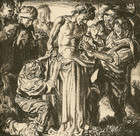Frank Brangwyn
(1867-1956)
During the ten years I worked in Midtown Manhattan, I passed through the old RCA Building at Rockefeller Center several times a week without paying much attention to its huge, sepia-toned Art Deco murals. I look at the decorations in the lobby with an admiring eye, now, especially the fourth mural to the left side of the elevator banks, the last in a series on the rise of civilization, painted by British Artist Frank Brangwyn in the early 1930s.
Near the top of the panel, a hooded figure, straight out of the Bible, can be seen from behind, standing on a hill, his arms in the air (much like The Preacher in a Brangwyn etching). The crowd massed to the Teacher's back in the foreground of the picture is a rag tag assortment of humanity. Gentlemen in top hats, hobos, buxom matrons, squirming children, and, at least, one sleeping dog.
Depicting the Sermon on the Mount from behind may hardly be a traditional take on the story, but such eccentric touches are a hallmark of Brangwyn's art. This self-taught painter and onetime apprentice to William Morris (leader of the Arts and Crafts Movement) is yet another notable early 20th century artist, all but forgotten in the era of dogmatic Modernism. Brangwyn not only excelled as a muralist, book illustrator, and print maker but also won fame as a designer of stained glass windows, ceramics, furniture, and even wall-paper. Fortunately, changing times and changing tastes have brought Brangwyn out of the shadows.
The Belgian-born artist was Roman Catholic, the son of an British architectural designer who often took on ecclesiastical commissions. As the artist liked to recall, he came into the world in the shadow of Bruges Cathedral, within the sound of its bells. Religious themes appear frequently in his work. Brangwyn was especially drawn to images of saints, monks, nuns, and the downtrodden and dispossessed, who often take center stage in starkly realistic biblical scenes like his etching of The Nativity (seen here in two variations), set in a rustic French inn.
Brangwyn was the prolific illustrator of over 80 books. Seven prints from three of these titles can be found in the Sacred Art Pilgrim Collection. There are two woodcuts from Belgian Poet Emile Verhaeren's Les Villes Tentaculaires, capturing the dark, seething atmosphere of this apocalyptic vision of life in over-industrialized, octopus-like urban centers. Three etchings come from L'Ombre de la Croix by French Writers Jerome and Jean Tharaud, offering glimpses into the life of early 20th century Central European Jews, who must live in the shadow of the Cross, as a minority people in a predominantly Christian culture. Two more etchings formed part of a suite of 32 small format prints, illustrating The Book of Job.
The Stations of the Cross was a sacred theme of special importance to Brangwyn. As he told his artist-biographer, William de Belleroche, the subject was “at the back of my mind all of my life, " and he hoped to make it his "most important work.” Brangwyn was commissioned in 1920 to create a cycle of Stations of the Cross paintings for the war-damaged cathedral in Arras, France. The project was never completed, but Brangwyn made hundreds of studies and sketches.
With the help of Belleroche, Brangwyn eventually produced a set of woodcuts on the theme between 1930 and 1934 and a lithographic series in 1935. (My collection has one woodcut of Station III, and two sketches for the lithographic plates of Station II and Station X ; the first sketch includes two self-portraits of Brangwyn and a drawing of his dog, Roger!)
In the preface to an edition of Brangwyn reproductions, titled The Way of the Cross, Roman Catholic Writer G. K. Chesterton noted a certain “Christian exuberance, which piled itself up to overflowing,” in the artist’s work, reminiscent of the Baroque painter, Peter Paul Rubens. But Chesterton also detected an "ugly energy” in the crowd scenes, more like Flemish medieval art, which he considered “more attractive than vulgar beauty.” The dramatic, sometimes brutal urgency of Brangwyn’s figurative compositions makes his imagery of Christ’s Passion outstanding sacred art.
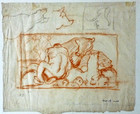
The Prodigal Son
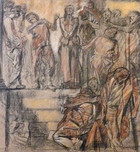
Mocking of Christ (1912)
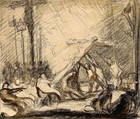
The Crucifixion
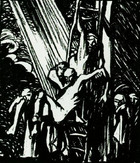
The Deposition
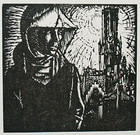
The Nun
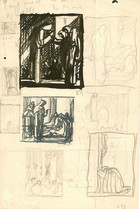
Page of Religious Sketches
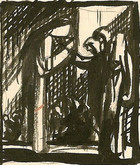
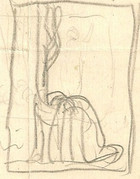
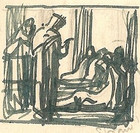

Nativity I

Nativity II
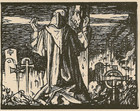
Praying Monk
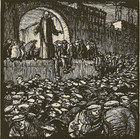
The Monk in the City
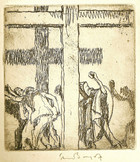
The Shadow of the Cross (Title page)
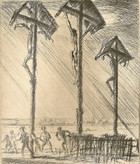
Roadside Crucifix

Three Crosses
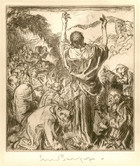
The Preacher
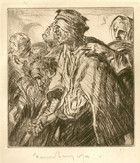
The Blind Man
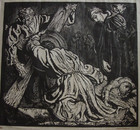
Station III
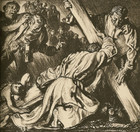
Station III (illustration)
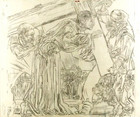
Station II
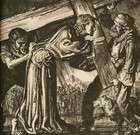
Station II (illustration)
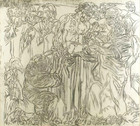
Station X
